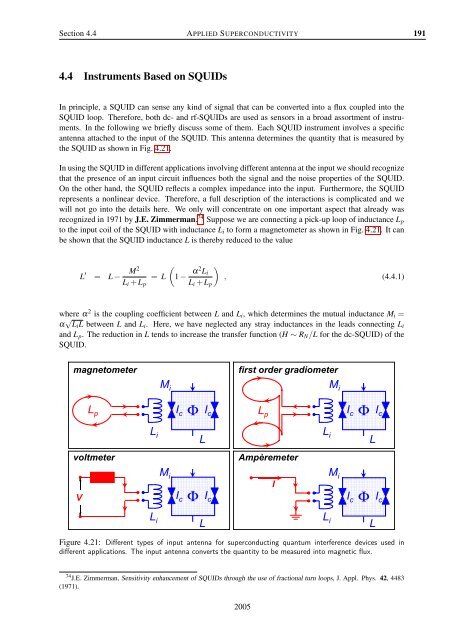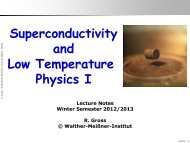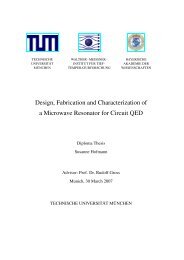Applied Superconductivity - Walther Meißner Institut - Bayerische ...
Applied Superconductivity - Walther Meißner Institut - Bayerische ...
Applied Superconductivity - Walther Meißner Institut - Bayerische ...
- No tags were found...
You also want an ePaper? Increase the reach of your titles
YUMPU automatically turns print PDFs into web optimized ePapers that Google loves.
Section 4.4 APPLIED SUPERCONDUCTIVITY 1914.4 Instruments Based on SQUIDsIn principle, a SQUID can sense any kind of signal that can be converted into a flux coupled into theSQUID loop. Therefore, both dc- and rf-SQUIDs are used as sensors in a broad assortment of instruments.In the following we briefly discuss some of them. Each SQUID instrument involves a specificantenna attached to the input of the SQUID. This antenna determines the quantity that is measured bythe SQUID as shown in Fig. 4.21.In using the SQUID in different applications involving different antenna at the input we should recognizethat the presence of an input circuit influences both the signal and the noise properties of the SQUID.On the other hand, the SQUID reflects a complex impedance into the input. Furthermore, the SQUIDrepresents a nonlinear device. Therefore, a full description of the interactions is complicated and wewill not go into the details here. We only will concentrate on one important aspect that already wasrecognized in 1971 by J.E. Zimmerman. 74 Suppose we are connecting a pick-up loop of inductance L pto the input coil of the SQUID with inductance L i to form a magnetometer as shown in Fig. 4.21. It canbe shown that the SQUID inductance L is thereby reduced to the valueL ′ = L − M2L i + L p= L( )1 − α2 L iL i + L p, (4.4.1)where α 2 is the coupling coefficient between L and L i , which determines the mutual inductance M i =α √ L i L between L and L i . Here, we have neglected any stray inductances in the leads connecting L iand L p . The reduction in L tends to increase the transfer function (H ∼ R N /L for the dc-SQUID) of theSQUID.magnetometerfirst order gradiometerM iM iL pI cΦ I c L pI c Φ I cL iLL iLvoltmeterAmpèremeterM iI cΦI cV I c I cIM iΦL iLL iLFigure 4.21: Different types of input antenna for superconducting quantum interference devices used indifferent applications. The input antenna converts the quantity to be measured into magnetic flux.74 J.E. Zimmerman, Sensitivity enhancement of SQUIDs through the use of fractional turn loops, J. Appl. Phys. 42, 4483(1971).2005
















